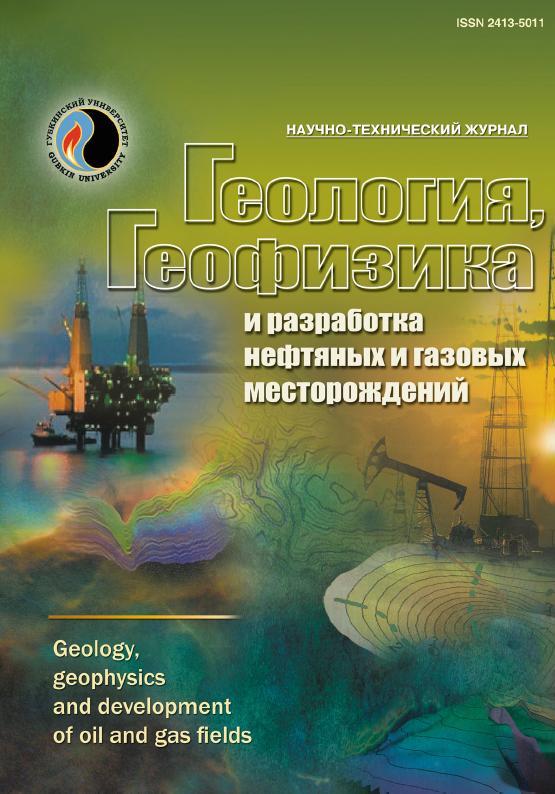Application of the data on the core luminescence intensity in ultraviolet light to substantiate the saturation of the Jurassic layered clay reservoirs
UDC: 550.8.053
DOI: -
Authors:
BRYUKHANOVA EKATERINA V. 1,2
1,2,
GILMANOVA NATALYA V. 1,2
1,2,
SPIRINA ANASTASIA M. 1
1,
MOSKALENKO NATALYA YU. 1,2
1,2
1 LUKOIL-Engineering LLC, Tyumen, Russia
2 Tyumen Industrial University, Tyumen, Russia
Keywords: oil saturation coefficient, core luminescence intensity, core photographs, permeability coefficient, layered clay content
Annotation:
The authors of the article consider the Jurassic deposits represented by various types of layering, the thickness of which varies from 2...10 to 30 cm. The layered texture affects the readings of GIS methods, in particular the readings of electrical methods, which, in turn, affects the reliability of determining the oil saturation coefficient of texturally heterogeneous objects (layered reservoirs). The developed "IntensDet" software module, which processes photographs based on pattern recognition, allows automatic calculation of luminescence intensity of rocks’ oil saturation level by core photographs in ultraviolet (UV) light and accordingly predict the oil saturation coefficient of layered reservoirs. The authors of the article present the experience of using a software module to evaluate and compare the level of core luminescence intensity (brightness) of glow with the oil saturation coefficient of a layered reservoir. An example is given of comparing core luminescence intensity with the values of the oil saturation coefficient determined by the core, with corrections for layered reservoirs. The possibility of improving the luminescence intensity by dividing the intensity according to the permeability coefficient of the identified reservoir interlayers is also considered.
Bibliography:
1. Botvinkina L.N. Sloistost’ osadochnykh porod // Trudy geologicheskogo instituta. – Vyp. 59. – M.: Izd-vo Akademii nauk SSSR, 1962. – 548 s.
2. Botvinkina L.N. Metodicheskoe rukovodstvo po izucheniyu sloistosti // Trudy geologicheskogo instituta. – Vyp. 119. – M.: Nauka, 1965. – 265 s.
3. Detal’noe izuchenie litologo-petrofizicheskikh svoystv teksturno-neodnorodnykh terrigennykh kollektorov Zapadnoy Sibiri / A.V. Akin’shin, D.B. Rodivilov, V.M. Yatsenko [i dr.] // Neft. khoz-vo. – 2023. – № 6. – S. 16–19. – DOI: 10.24887/0028-2448-2023-6-16-19
4. Efimov V.A., Akmanaev A.R., Akin’shin A.V. Opredelenie doli glinistykh prosloev i vklyucheniy po fotografiyam kolonki kerna // Neft. khoz-vo. – 2013. – № 10. – S. 88–90.
5. Moskalenko N.Yu., Gil’manova N.V., Boronin P.A. Vozmozhnosti ispol’zovaniya standartnykh metodov GIS s razlichnoy razreshayushchey sposobnost’yu pri opredelenii podschetnykh parametrov kollektorov so sloistoy glinistost’yu // Geologiya, geofizika i razrabotka neftyanykh i gazovykh mestorozhdeniy. – M.: OAO "VNIIOENG", 2017. – № 9. – S. 47–51.
6. Dol’ G.G. Potentsialy SP v glinistykh peskakh / Pod red. V.N. Dakhnova // Voprosy promyslovoy geofiziki: sb. statey. – M.: Gostoptekhizdat, 1957. – S. 308–329.
7. Vendel’shteyn B.Yu. Issledovanie razrezov neftyanykh i gazovykh skvazhin metodom sobstvennykh potentsialov. – M.: Nedra, 1966. – 206 s.
8. Mamyashev V.G., Bryukhanova E.V. Kharakteristika sostoyaniya i napravleniya razvitiya metodicheskogo obespecheniya izucheniya teksturno-neodnorodnykh porod po dannym geofizicheskikh issledovaniy skvazhin // Izv. vuzov. Neft’ i gaz. – 2022. – № 1. – S. 38–50. – DOI: 10.31660/0445-0108-2022-1-38-50
9. Ispol’zovanie intensivnosti svecheniya kerna v ul’trafioletovom svete dlya obosnovaniya granichnykh znacheniy i nasyshchennosti nizkopronitsaemykh kollektorov / A.M. Spirina, N.V. Gil’manova, N.Yu. Moskalenko, K.Ya. Gil’manova // Geologiya, geofizika i razrabotka neftyanykh i gazovykh mestorozhdeniy. – 2023. – № 10(382). – S. 77–83. – DOI: 10.33285/2413-5011-2023-10(382)-77-83
10. Petrofizicheskie metody issledovaniya kernovogo materiala. (Terrigennye otlozheniya) / M.K. Ivanov, Yu.K. Burlin, G.A. Kalmykov [i dr.]: uchebn. posobie v 2 kn. – Kn. 1. – M.: Izd-vo Mosk. un-ta, 2008. – 112 s.

